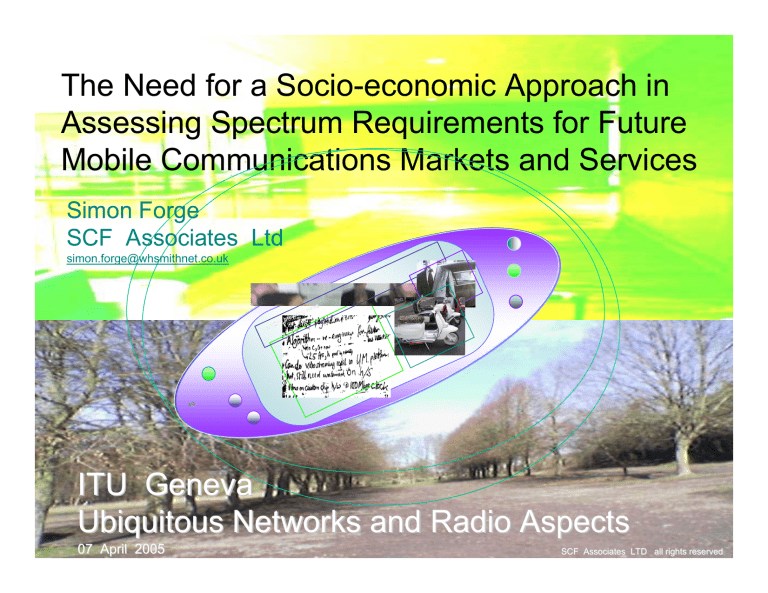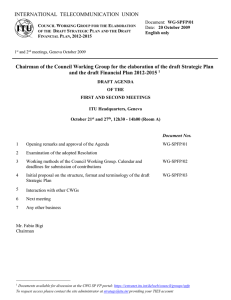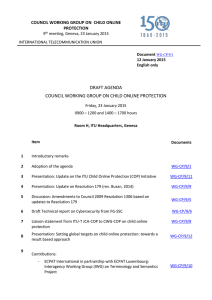The Need for a Socio-economic Approach in
advertisement

The Need for a Socio-economic Approach in Assessing Spectrum Requirements for Future Mobile Communications Markets and Services Simon Forge SCF Associates Ltd simon.forge@whsmithnet.co.uk s new ng a ki bre CN NY 4g ITU Geneva Ubiquitous Networks and Radio Aspects SCF Associates LTD SCF Associates LTD 07 Ubiquitous April 2005 ITU Geneva networks and Radio Aspects SCF Associates Ltd all rights reserved 1 SCF Associates LTD all rights reserved New services have often been mysteries to the industry - greatly underestimated or overestimated Telecoms Industry view at launch The consumer speaks – the ‘street’ view ISDN The next generation of telecoms- replace POTS UK / USA : “Idiot Services users Don’t Need” WAP The mobile user will really go for this technology “WAP is crap” - expensive, no services, difficult to use Iridium LEOs Just what the remote business traveller needs 20 times too expensive Internet/WWW Ignore.... Oh still there ?!! ..horror -stifle! ..VoIP wins Just use it (@ no cost) GSM – digital mobile An extra (minor) feed for our fixed networks Just what we need! - till we see the bill ! -so PAYG rules SMS Minor supplementary service (CLASS for Mobile) The only service (mobile or fixed) for many users While some of the biggest product launches in communications services over the last 20 years have delivered flops, seemingly trivial services have exploded. ITU Geneva Ubiquitous networks and Radio Aspects SCF Associates Ltd all rights reserved 2 We need a better strategy to assess spectrum demands - the underlying concepts and policy need to be improved as we have a rapidly evolving market with exploding demand – - a discontinuity in radio technology could occur at any time, in order to cater for a far larger user population than the industry has ever seen before as radio exceeds fixed line, and this effect is price sensitive - a transformation is under way from a mobile communications market for the transport of plain vanilla voice, over networks, towards a media and commercial transaction environment and again this effect is price sensitive However, many players in the traditional telecommunications world have yet to fully realise these developments will occur. Any useful approach must take account of this - it should track the most likely path for customer demand based on needs and income and the healthy development of radio services, not biased by a technical view or that of specific short-term interests. ITU Geneva Ubiquitous networks and Radio Aspects SCF Associates Ltd all rights reserved 3 The context – a global user population growth Billions of mobile services users worldwide •With globalisation, costs of services and handsets will slowly be set by average world prices •Saturation is set by affordable price for the majority of users – numbers which may reach near 65% of a global population of over 7.5Bn by 2020 = 5Bn users 5 4 3 2 Bn, 2006/7 2 estimated 1.5Bn, 2004 1 800K, 2000 0 1985 1990 ITU Geneva Ubiquitous networks and Radio Aspects 1995 2000 SCF Associates Ltd 2005 2010 all rights reserved 2015 2020 4 Potential take-up of radio services: from communication to mobile applications relies on a price benevolent context for disposable income levels of the global mass market Number of Mobile Applications in mass usage Applications service business 1000 Network service business 100 10 1 Phase 1 Network Communications services Voice Voice & SMS 1985 1990 ITU Geneva Ubiquitous networks and Radio Aspects 1995 2000 SCF Associates Ltd Phase 2 First Applications phase 2005 2010 all rights reserved Phase 3 Second Applications phase 2015 2020 5 Usage of a Public Service is dictated by cost – with demand following to the Dupuit Curve (1840) Price of service High activity area of curve– where Disposable income makes service affordable – so- service chosen depends on affordability – -In Philippines, SMS is most affordable service – some phones never used for voice -Youth/ Children in OECD countries often only use texting An added concept : the ‘Perception of freeness’ = unlimited usage User Population ITU Geneva Ubiquitous networks and Radio Aspects SCF Associates Ltd all rights reserved 6 Understanding the potential take-up of services Measure against:-utility value to users -affordability -accessibility ACCESSIBILITY High take-up space -Useful -Affordable -Available (accessible ubiquitously) High UTILITY VALUE High Low Low Low ITU Geneva Ubiquitous networks and Radio Aspects High SCF Associates Ltd all rights reserved AFFORDABILITY to user (includes terminal) 7 Mapping the potential of services to succeed GSM voice Mobile Internet Services (if secure) SMS ACCESSIBILITY MP3 download High High take-up space -Useful -Affordable -Available (ubiquitous) 3G Services 2005 UTILITY VALUE Fixed Internet Services (Unprotected) High Fixed Line Voice 2005 Fixed Line Voice 1950 Telegraph ISDN 1850 Low Low WAP-1 Low ITU Geneva Ubiquitous networks and Radio Aspects High SCF Associates Ltd all rights reserved AFFORDABILITY to user (includes terminal) 8 The strategy going forward in spectrum – what form of spectrum allocation suits each type of underlying technology? Usable Freq range (Actual range) Differentiation mechanism Form of spectrum assignment Assigned Bands + Guard bands 2G FDD & TDD & Limited Spread spectrum CDMA 0.3 – 3.5 GHz (0.45- 2.3 GHz) 2.5G FDD & TDD & Limited Spread spectrum CDMA 0.4 – 3.5 GHz (0.45- 2.3 GHz) Assigned Bands + Guard bands 3G Limited Spread spectrum W-CDMA/ CDMA-2000 0.4 – 3.5 GHZ (2.5- 3.3GHz) Assigned Bands + Limited Guard bands 4G Other NONcellular AWTs* (WiFi etc) Spread spectrum Under 5 GHZ, possibly 6-10 GHz Unlicenced spectrum, possibly in bands Limited Spread spectrum/other Under 5 GHZ, possibly 6-10 GHz Unlicenced spectrum, possibly in bands *Alternative wireless technologies ITU Geneva Ubiquitous networks and Radio Aspects SCF Associates Ltd all rights reserved 9 Growth of take-up of radio services Services & capacity available Number of Mobile Applications in mass usage 1000 Take-up Machine to machine ubiquitous services AMI- style Lifestyle multimedia services at low cost 100 Multimedia and transaction services with 2.5G and 3G constraints on affordability and richness 10 2.5G Data and WAP Voice SMS 1 1985 1990 ITU Geneva Ubiquitous networks and Radio Aspects 1995 2000 SCF Associates Ltd 2005 2010 all rights reserved 2015 2020 10 Our perspective of demand is economic – it sets social and technical parameters and features Economic parameters Social parameters ITU Geneva Ubiquitous networks and Radio Aspects Technical parameters SCF Associates Ltd all rights reserved 11 Focus on user needs gives a balanced estimate of future mobile services Economic /Financial Setting Questions to be answered User/ Social/Cultural environment Market/ Regulatory Supplier industry / Technology/ environment What are the services that are wanted? What are the services that are to be offered? ITU Geneva Ubiquitous networks and Radio Aspects SCF Associates Ltd all rights reserved 12 How can we draw socio-economic pictures of future demand ? - paint Scenarios Assign individual theme within domain of interest with drivers Assumptions Scenario Framework (Static) Assertions List Known key Variables Hypotheses (to be tested) Causal Impacts analysis Scenario Behaviour (Dynamics) Relevance trees ITU Geneva Ubiquitous networks and Radio Aspects Scenario SCF Associates Ltd Scenario Construction for Forecasting all rights reserved 13 Scenarios generate motivations & user types with needs analysis Disposable income Applications User Profiles – usage types Application Attributes Network Services Needs Scenarios Socio - economic patterns User Population by type Content Services Cost vs. Disposable income Traffic Motivations Usage levels (amount of use) - and eventually applications, services, content and traffic ITU Geneva Ubiquitous networks and Radio Aspects SCF Associates Ltd all rights reserved 14 The study for IPTS : - FMS IPTS /DG JRC/EC Future Mobile Services Future Mobile Services and Markets in Europe http://fms.jrc.es Simon Forge Colin Blackman Eric Bohlin SCF Associates Ltd ITU Geneva Ubiquitous networks and Radio Aspects SCF Associates Ltd all rights reserved 15 The whole FMS method can be summarised as 6 steps – based on the economic, social and technical parameters 1…X scenarios Relative Disposable Incomes between scenarios Motivations ITU Geneva Ubiquitous networks and Radio Aspects User Types Needs Relative Degree of Usage of Applications Applications (eg financial Transactions) SCF Associates Ltd Amount of Usage Traffic Volume Services Traffic type all rights reserved 16 The FMS method can be mapped on to the economic, social and technical parameters Numbers of Users in High/ medium/ Low income bracket, by Epoch Economic parameters Relative Disposable incomes User types Degree of usage of Applications Amount of usage Traffic Volume Services Traffic type 1…X scenarios Motivations Needs Applications (eg financial transactions) Social parameters ITU Geneva Ubiquitous networks and Radio Aspects Technical parameters SCF Associates Ltd all rights reserved 17 Mapping scenarios - against the economic and sociological conditions Favour the take up of services Main scenarios Scenario 1: Smooth Development Wild card disruptive scenarios – may occur within any main scenario Scenario 3: Constant Change Economic conditions Scenario 2: Economic stagnation Scenario 5: Natural Or Man-made International Disaster Inhibit take the up of services Favourable ITU Geneva Ubiquitous networks and Radio Aspects Social/ cultural/ political conditions SCF Associates Ltd all rights reserved Scenario 4: Financial Crash Unfavourable 18 Comparing development in the Main Socio-Economic Scenarios Scenario 2010 2005 1 SMOOTH 2015 2020 150% 100% 2 ECONOMIC 100% STAGNATION 90% 80% 3 CHANGE – 110% Changing regions of prosperity 100% 90% EU Economic output ITU Geneva Ubiquitous networks and Radio Aspects Mean Disposable income 2005 -2020 SCF Associates Ltd all rights reserved 19 ITU Geneva Ubiquitous networks and Radio Aspects SCF Associates Ltd all rights reserved 20


